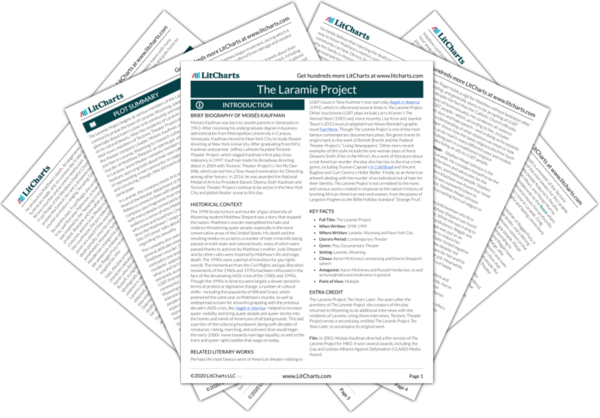Summary
Analysis
The narrator contextualizes the following dialogue as excerpts from the journal entries of members of the theater company. Andy Paris begins reciting part of his journal in which he describes Moisés Kaufman introducing the idea of the Laramie Project. Stephen Belber talks about how he hesitated to take part in the project because he felt it was invasive. Amanda Gronich expresses her overwhelming sense of inexperience in conducting interviews. Finally, Kaufman states that the company agreed to go to Laramie to do interviews. He notes his own safety concerns with such a trip, but says that Rebecca Hilliker, the head of the university theater department, is going to introduce the company to people to interview.
Through excerpts from the playwrights’ journals, this scene shows the playwrights’ individual concerns going into The Laramie Project. By including these excerpts, the playwrights show that they entered into the project with an awareness of the potential problems they might encounter or create through their investigation. The playwrights are worried about how they could harm Laramie and could themselves be hurt while working on the project. Kaufman notes his safety concerns, while others worry their presence may be invasive.
Themes
This moment opens with a journal entry from Greg Pierotti describing how, on the day they arrived in Laramie, the theater company saw a herd of buffalo and a sign that said “Wyoming—like no place on earth.” Another member of the company, Leigh Fondakowski, describes stopping to eat at a local inn and interacting with a peculiar waitress. Moisés Kaufman admits that, upon arriving out West, the rest of the company had to explain to him what chicken fried steak was.
These journal entries focus on the company’s sense of foreignness in Wyoming. They marvel at a herd of buffalo and require explanations of chicken fried steak, suggesting that the New York-based company is deeply out of their element. This shows how the playwrights are newcomers and outsiders to Laramie, and so undercuts their authorial authority.
Themes
Company member Barbara Pitts talks about seeing the “Welcome to Laramie” sign the night they finally arrived in the town. After a strip of Walmarts and fast food chains, they arrived at a town that looked like “a turn-of-the-century Western” town. Barbara remembers one of the inns they passed was displaying a sign that said, “HATE IS NOT A LARAMIE VALUE.”
Barbara’s memory of a sign proclaiming that “HATE IS NOT A LARAMIE VALUE” shows how, even prior to the theater company’s arrival, the Laramie community was still grappling with its culture of homophobia and reevaluating its values following Matthew Shepard’s death.
Themes
In an excerpt from a journal entry, Moisés says the company is switching from a motel to a Best Western. Amanda Gronich talks about how the company is dividing up to attend different churches in the community, and she and Moisés attend a Baptist service.
As the playwrights begin to settle into Laramie (even switching to a nicer hotel), they engage with the town’s religious community by experiencing various church services firsthand.
Themes
Get the entire The Laramie Project LitChart as a printable PDF.













